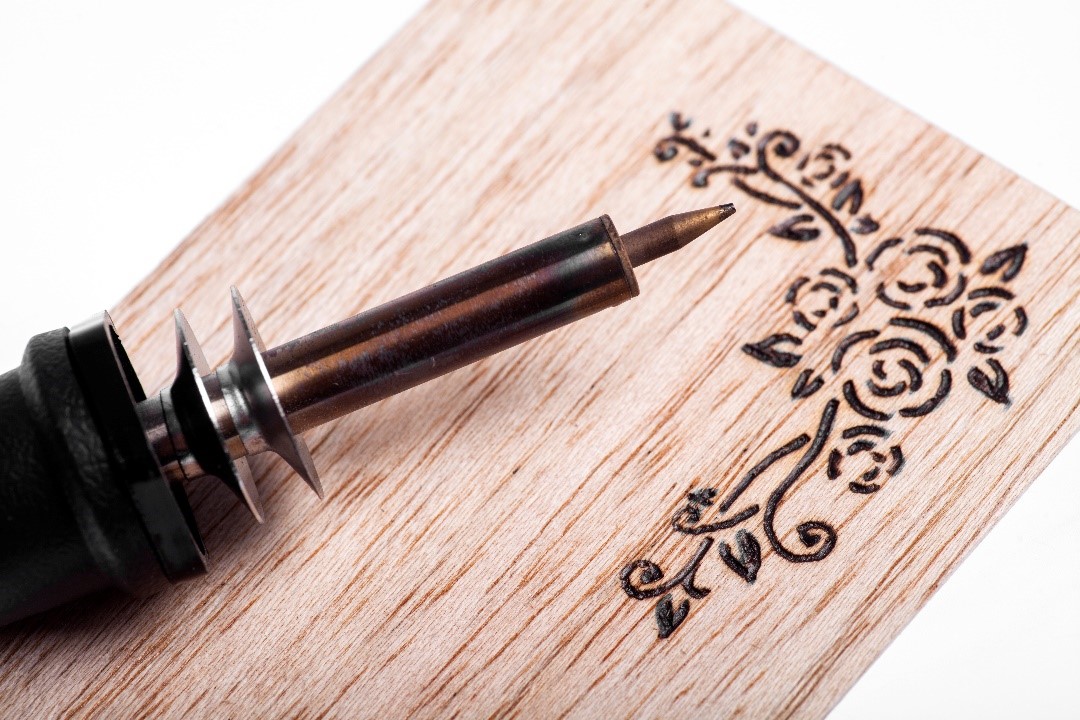The Art of Pyrography
Contents |
Introduction
Pyrography is the process of applying heat to wood to burn marks and decoration into it. By using basic tools such as a soldering iron this method can create works of art from timber.
Sometimes referred to as Pyrogravure, pokerwork or wood burning, by controlling the application of heat with such tools as a poker, a broad range of tones and shades can be applied.
The history of wooden art
The term means ‘writing with fire’ and combines the Greek pur (fire) and graphos (writing). The art of burning wood can be practised using specialised tools and equipment or a metal implement simply heated from fire, or even a magnifying lens concentrated by sunlight. It began in the 17th century, and became increasingly popular by the 19th century, in a crude form of pokerwork.
During the Victorian era, the pyrography machine sparked huge interest in woodcraft, and the term was coined. As time progressed, the 19th century saw an even bigger curiosity, and in the 20th century, the electric pyrography hot wire wood etching machine further automated the process.
Woods and pyrography
This method works best with fine grain woods such as lime, beech or sycamore, which are also best for beginners. For safety reasons, pyrography should not be practised on pressure treated woods or composite materials such as plywood or MDF.
Essentially you can use any wood for a pyrography project, although soft woods will burn at lower temperatures, while harder woods will only take to alteration from higher temperatures. A key point is to prepare your wood. If it is a raw piece of wood, you will need to sand it suitably depending on the way you want the grain. It is much easier to burn with the way of the grain.
Varying the tip, the temperature of the iron, or the way of applying it can achieve many different effects. In most pyrography, after the wood is burned, it is usually coloured. Lighter hardwoods, like sycamore, basswood, birch and beech are a common wood to be used as the fine grain is not obtrusive.
Characteristics of wood in pyrography
The wood you choose in pyrography can change the finished effect. From the hardness, to the grain, figure, texture and colour, the classification of wood will affect the art. Softwood burns faster than hardwood, so do not require the marker to be as hot.
The grain is the direction of the fibres in the cells of the wood - it is important to sand with the grain. It is a key factor, as it can cause deviation when using a woodturning pen unless pressure is applied.
The figure is the natural design or pattern visible from the cut surface of the wood. This should always be taken into consideration when planning your pyrography design. The texture of the wood can also change your planning.
Whether a beginner or an expert, you should avoid creating intricate designs on uneven or coarse wood textures. Wood-burning should simply enhance the natural beauty of the wood, so try not to hide the natural texture, or grain if possible.
Related articles on Designing Buildings
Featured articles and news
The UK's Modern Industrial Strategy: A 10 year plan
Previous consultation criticism, current key elements and general support with some persisting reservations.
Building Safety Regulator reforms
New roles, new staff and a new fast track service pave the way for a single construction regulator.
Architectural Technologist CPDs and Communications
CIAT CPD… and how you can do it!
Cooling centres and cool spaces
Managing extreme heat in cities by directing the public to places for heat stress relief and water sources.
Winter gardens: A brief history and warm variations
Extending the season with glass in different forms and terms.
Restoring Great Yarmouth's Winter Gardens
Transforming one of the least sustainable constructions imaginable.
Construction Skills Mission Board launch sector drive
Newly formed government and industry collaboration set strategy for recruiting an additional 100,000 construction workers a year.
New Architects Code comes into effect in September 2025
ARB Architects Code of Conduct and Practice available with ongoing consultation regarding guidance.
Welsh Skills Body (Medr) launches ambitious plan
The new skills body brings together funding and regulation of tertiary education and research for the devolved nation.
Paul Gandy FCIOB announced as next CIOB President
Former Tilbury Douglas CEO takes helm.
UK Infrastructure: A 10 Year Strategy. In brief with reactions
With the National Infrastructure and Service Transformation Authority (NISTA).
Ebenezer Howard: inventor of the garden city. Book review.
The Grenfell Tower fire, eight years on
A time to pause and reflect as Dubai tower block fire reported just before anniversary.
Airtightness Topic Guide BSRIA TG 27/2025
Explaining the basics of airtightness, what it is, why it's important, when it's required and how it's carried out.
Construction contract awards hit lowest point of 2025
Plummeting for second consecutive month, intensifying concerns for housing and infrastructure goals.
Understanding Mental Health in the Built Environment 2025
Examining the state of mental health in construction, shedding light on levels of stress, anxiety and depression.























